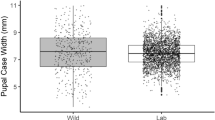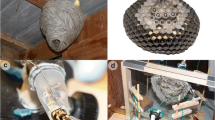Summary
Highly male-biased investment ratios (1:2.86, F:M, biomass wet weight) were found among reproductives reared by 32 Bombus terricola colonies set out in the field and 35 B. melanopygus colonies held in laboratory confinement. The numerical sex ratios were almost identical for the two species (1 queen to 6.1 males). Most of the males were produced early in the season by small weak colonies. It is argued that in a population where some colonies are ‘orphaned’ and rear only males, female-biased sex ratios are expected among the surviving queen-producing colonies.
Similar content being viewed by others
References
Alexander RD (1974) The evolution of social behavior. Annu Rev Ecol Syst 5:325–383
Alexander RD, Sherman PW (1977) Local mate competition and parental investment in social insects. Science 196:494–500
Benford FA (1978) Fisher's theory of the sex ratio applied to the social hymenoptera. J Theor Biol 72:701–727
Herbers JM (1979) The evolution of sex-ratio strategies in Hymenopteran societies. Am Nat 114:818–834
Macnair MR (1978) An ESS for the sex ratio in animals with particular reference to the social hymenoptera. J Theor Biol 70:449–459
Noonan KM (1978) Sex ratio of parental investment in colonies of the social wasp Polistes fuscatus. Science 199:1354–1356
Oster G, Wilson EO (1978) Caste and ecology in the social insects. Princeton University Press, Princeton
Oster G, Eshel I, Cohen D (1977) Worker-queen conflict and the evolution of social insects. Theor Pop Biol 12:49–85
Owen RE, Plowright RC (1980) Abdominal pile color dimorphism in the bumble bee Bombus melanopygus. J Hered 71:241–247
Plowright RC (1967) On the distribution of bumblebees in Norfolk. Trans Norfolk Norwich Nat Soc 21:48–88
Plowright RC, Jay SC (1966) Rearing bumble bee colonies in captivity. J Apic Res 5:155–165
Pomeroy N (1979) Brood bionomics of Bombus ruderatus in New Zealand (Hymenoptera: Apidae). Can Entomol 111:865–874
Siegal S (1956) Nonparametric statistics for the behavioral sciences. mcGraw-Hill, New York
Trivers RL, Hare H (1976) Haplodiploidy and the evolution of the social insects. Science 191:249–263
Wade MJ (1979) The evolution of social interactions by family selection. Am Nat 113:399–417
Webb MC (1961) The biology of the bumblebees of a limited area in eastern Nebraska. PhD dissertation, University of Nebraska
Author information
Authors and Affiliations
Rights and permissions
About this article
Cite this article
Owen, R.E., Rodd, F.H. & Plowright, R.C. Sex ratios in bumble bee colonies: Complications due to orphaning?. Behav Ecol Sociobiol 7, 287–291 (1980). https://doi.org/10.1007/BF00300669
Received:
Accepted:
Issue Date:
DOI: https://doi.org/10.1007/BF00300669




